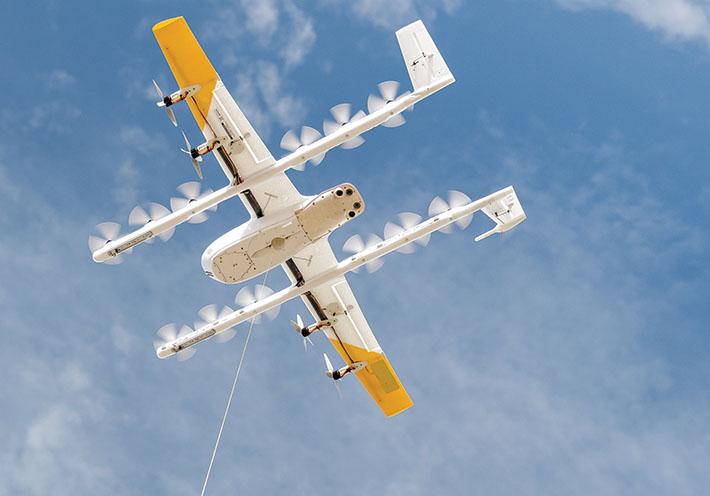Standards Enable the Future of Drone Operations

Standards Enable the Future of Drone Operations
In crewed aviation, technology development has traditionally come first, followed later by harmonization of industry practices through standards. This worked well for many years considering the moderate development pace of crewed aviation – and the fact that, regardless of their category and weight, crewed aircraft were mostly operated the same ways.
With uncrewed aircraft, however, a new approach has been necessary. Both regulators and the industry realize there is no “one-size” solution that fits all, and subsequently, rules need to be proportionate, operation-centric, and risk- and performance-based.
Moreover, integration of unmanned aircraft systems (UAS) into the airspace was identified as a critical challenge in recent times, and it quickly became clear to key regulators and industry stakeholders, including Wing, that the traditional paradigm to ensure safe operations needed to be rethought in order to cooperatively, safely, and digitally share the sky among all airspace users.
One viable path forward was to develop digital solutions that:
- Fit the needs of the industry;
- Enable a level-playing field where multiple UAS Traffic Management (UTM)/U-Space Service Providers can compete; and
- Use standardized mechanisms for interoperability.
With these goals in mind, the development of UAS technical standards was launched by ASTM International’s committee on unmanned aircraft systems (F38) parallel to the development of rules to support a successful, innovative development of new technologies – while maintaining safe operations in shared skies.
Standards Participation
Wing was excited to start with open solutions and standards from the beginning. The company recognized that the path forward was to work with industry and regulators on standards essential to sharing the airspace. This has included active roles in the development of two key interoperability standards for UTM/U-Space services, which are a cornerstone of safe, secure, and fair access to and use of the airspace:
- Specification for remote ID and tracking (F3411)
- Specification for UAS traffic management (UTM) UAS service supplier (USS) interoperability (F3548)
F3411 in particular accomplishes several things. The standard enables remote identification without requiring additional infrastructure or equipment. It supports a diverse range of UAS types, including those connected to the cell network, as well as a diverse range of UAS operators, including both recreational and commercial users. And it underpins transparency and privacy by providing third parties with information to identify an unmanned aircraft while ensuring that information is shared only when necessary.
The specification was the earliest UTM standard to be validated by the industry through major technology demonstrations including NASA/FAA UTM pilot programs in the U.S. and the Swiss U-Space Initiative in Europe. These demonstrations showed the benefits of remote identification and how network RID (N-RID) allows anyone – including public officials, remote pilots, or bystanders – to identify unmanned aircraft nearby. The demonstrations also proved the ability of different USSPs to exchange data via the Linux Foundation’s open-source InterUSS Platform, which implements the discovery and synchronization service (DSS) defined in F3411.
Wing has been engaged in the development of other standards as well:
- Standard practice for remote ID means of compliance to Federal Aviation Administration regulation 14 CFR Part 89 (WK80944). This will be used with F3411 to build Wing’s Remote ID solution in the U.S.;
- Standard practice for development of a durability and reliability flight demonstration program for low-risk unmanned aircraft systems (UAS) under FAA oversight (F3478).
F3478 is a pillar for the certification of UAS by the FAA and has recently been recognized by the European Union Aviation Safety Agency (EASA) in support of the functional-test based (FTB) means of compliance for EASA design verification activities. D&R/FTB approaches are essential for UAS manufacturers to gain assurance that UAS operated within certain operational boundaries meet the targeted safety objective for the intended type of operations, taking into account the risk associated with people on the ground and other airspace users.
What’s Next
Wing and ASTM are already working on the next steps to facilitate the recognition of the F38 standards by regulators globally, particularly in Europe where the U-Space regulation [implementing regulation (EU) 2021/664] will become applicable on January 26, 2023.
The committee on unmanned aircraft systems has launched a working group to map the committee’s standards to the U-Space regulation and its associated acceptable means of compliance (AMC) and/or guidance material (GM). ASTM will use the gaps identified through this mapping exercise to work on future updates of these standards and ensure 100% coverage of the regulation and its associated AMC and GM. Both F3411 and F3548 are expected to be recognized by EASA for the network remote identification and UAS flight authorization mandatory services.
Additionally, the recently convened Standards Evaluation Project supporting European Regulations for Drones (SHEPHERD) with Wing as technical lead, will complement ASTM’s activity through a technical assessment of a set of UAS standards, including several ASTM standards, against the specific operation risk assessment (SORA) methodology developed by the international initiative joint authorities for rulemaking of unmanned systems (JARUS) and recognized by EASA as AMC to Article 11 of implementing regulation (EU) 2019/947 on the authorization of UAS operations in the “specific” category.
Both ASTM mappings and SHEPHERD technical assessment will be made available to the EASA, standards-development organizations (SDOs), and the UAS community. This availability will facilitate discussions between regulators and industry during the USSP certification process and/or the UAS type-certificate/design verification process, working to ensure harmonization and reduce barriers to entry for a diverse and collaborative UAS/UTM ecosystem.
The exercise is not expected to be set in stone but to continue to evolve with cross-industry, regulator, standards bodies, and regional learnings. ■
Company Snapshot
Company: Wing Aviation
Company headquarters: Palo Alto, CA, USA
Description: Wing Aviation is a drone-delivery company whose main objective is to provide safer, faster, and greener alternatives to transport by road.
Number of staff who are ASTM members: 5
Trading area: Global (USA, Australia, Finland)